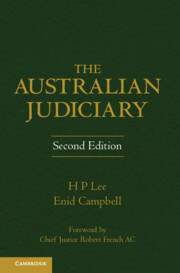Book contents
- Frontmatter
- Contents
- Preface
- Acknowledgments
- Table of Cases
- Table of Statutes
- Chapter 1 Introduction
- Chapter 2 The courts and judges
- Chapter 3 The judiciary as a branch of government
- Chapter 4 Appointment and conditions of service
- Chapter 5 Removal, suspension and discipline of judges
- Chapter 6 Judicial conduct
- Chapter 7 Extra-judicial activities of judges
- Chapter 8 Protecting judicial institutions
- Chapter 9 The accountability of judges
- Chapter 10 A public trust
- Appendix 1 Judicial statistics tables
- Guide to Judicial Conduct
- Index
- References
Chapter 5 - Removal, suspension and discipline of judges
Published online by Cambridge University Press: 05 December 2012
- Frontmatter
- Contents
- Preface
- Acknowledgments
- Table of Cases
- Table of Statutes
- Chapter 1 Introduction
- Chapter 2 The courts and judges
- Chapter 3 The judiciary as a branch of government
- Chapter 4 Appointment and conditions of service
- Chapter 5 Removal, suspension and discipline of judges
- Chapter 6 Judicial conduct
- Chapter 7 Extra-judicial activities of judges
- Chapter 8 Protecting judicial institutions
- Chapter 9 The accountability of judges
- Chapter 10 A public trust
- Appendix 1 Judicial statistics tables
- Guide to Judicial Conduct
- Index
- References
Summary
Removal of judges
Historically, judges appointed by the English monarch held office at the pleasure of the Crown (durante bene placito). Thus, it was possible for judges to be dismissed peremptorily and without cause. The struggle between the English Parliament and the Crown, which ultimately led to the subjugation of the latter to the former, also led to the advancement of judicial independence. Judicial independence of the Crown was eventually secured by Article III, s 7 of the Act of Settlement 1701 (Eng), which provided as follows:
The judges’ commissions be made quamdiu se bene gesserint [during good behaviour] and their salaries ascertained and established; but upon the address of both Houses of Parliament it may be lawful to remove them.
At the federal level, judicial independence was given constitutional protection in s 72(ii) of the Commonwealth Constitution. This provides that federal judges (that is, Justices of the High Court and judges of the other courts created by the Commonwealth Parliament) ‘[s]hall not be removed except by the Governor-General in Council, on an address from both Houses of Parliament in the same session, praying for such removal on the ground of proved misbehaviour or incapacity’. In the case of South Australia, Western Australia and Tasmania, it is simply provided that it would be lawful to remove judges of the Supreme Court upon the address of both Houses of Parliament, although the Supreme Court judges in South Australia and Western Australia are stated by a separate provision to hold and remain in office ‘during good behaviour’. The grounds of ‘proved misbehaviour’ or ‘incapacity’ are expressly specified in New South Wales, Queensland, Victoria, the Northern Territory and the Australian Capital Territory.
The standard mode of removal is an address of both Houses of Parliament in New South Wales, South Australia, Victoria and Western Australia, or an address of the Legislative Assembly in Queensland (the only State with a bicameral parliament), the Northern Territory and the Australian Capital Territory. In addition, Victoria, Queensland and the Australian Capital Territory all provide for the convening of ad hoc bodies where an allegation of misbehaviour or incapacity has been made to the designated authority. These bodies are tasked with determining whether on the facts the misbehaviour or incapacity of the judge warrants his or her removal as a step prior to an address in Parliament to remove the judge.
- Type
- Chapter
- Information
- The Australian Judiciary , pp. 116 - 151Publisher: Cambridge University PressPrint publication year: 2012



